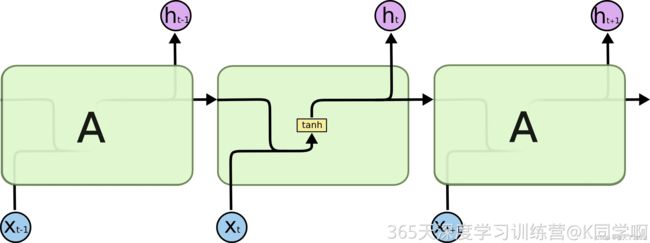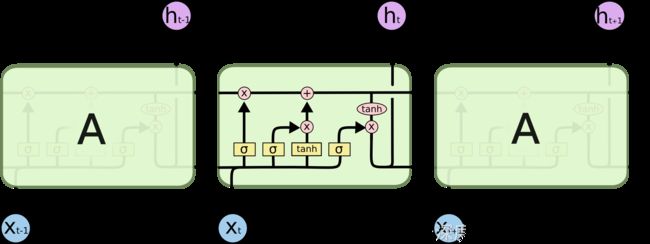深度学习Week13-火灾温度预测(LSTM)
- 本文为365天深度学习训练营 中的学习记录博客
- 参考文章:第R2周:LSTM-火灾温度预测(训练营内部可读)
- 作者:K同学啊
任务说明:数据集中提供了火灾温度(Tem1)、一氧化碳浓度(CO 1)、烟雾浓度(Soot 1)随着时间变化数据,我们需要根据这些数据对未来某一时刻的火灾温度做出预测(本次任务仅供学习)
要求:
1了解LSTM是什么,并使用其构建一个完整的程序
2R2达到0.83
拔高:
1使用第1~8个时刻的数据预测第9~10个时刻的温度数据
一句话介绍LSTM,它是RNN的进阶版,如果说RNN的最大限度是理解一句话,那么LSTM的最大限度则是理解一段话,详细介绍如下:
LSTM,全称为长短期记忆网络(Long Short Term Memory networks),是一种特殊的RNN,能够学习到长期依赖关系。LSTM由Hochreiter & Schmidhuber (1997)提出,许多研究者进行了一系列的工作对其改进并使之发扬光大。LSTM在许多问题上效果非常好,现在被广泛使用。
所有的循环神经网络都有着重复的神经网络模块形成链的形式。在普通的RNN中,重复模块结构非常简单,其结构如下:
LSTM避免了长期依赖的问题。可以记住长期信息!LSTM内部有较为复杂的结构。能通过门控状态来选择调整传输的信息,记住需要长时间记忆的信息,忘记不重要的信息,其结构如下:
一.前期准备工作
1.导入数据
数据地址:百度网盘
import tensorflow as tf
import pandas as pd
import numpy as np
gpus = tf.config.list_physical_devices("GPU")
if gpus:
tf.config.experimental.set_memory_growth(gpus[0], True) #设置GPU显存用量按需使用
tf.config.set_visible_devices([gpus[0]],"GPU")
print(gpus)[PhysicalDevice(name='/physical_device:GPU:0', device_type='GPU')]
顺便先导入数据
df_1 = pd.read_csv("woodpine2.csv")
df_1.head()2.数据可视化
import matplotlib.pyplot as plt
import seaborn as sns
plt.rcParams['savefig.dpi'] = 500 #图片像素
plt.rcParams['figure.dpi'] = 500 #分辨率
fig, ax =plt.subplots(1,3,constrained_layout=True, figsize=(14, 3))
sns.lineplot(data=df_1["Tem1"], ax=ax[0])
sns.lineplot(data=df_1["CO 1"], ax=ax[1])
sns.lineplot(data=df_1["Soot 1"], ax=ax[2])
plt.show()
二、构建数据集
dataFrame=df_1.iloc[:,1:]
print(dataFrame)1.设置X,y
width_X=8
width_y=2
取前8个时间段的Tem1、CO 1、Soot 1为X,而第9,10个时间段的Tem1为y。
X = []
y = []
in_start = 0
for _, _ in df_1.iterrows():
in_end = in_start + width_X
out_end = in_end + width_y
if out_end < len(dataFrame):
X_ = np.array(dataFrame.iloc[in_start:in_end, ])
X_ = X_.reshape((len(X_) * 3))
y_ = np.array(dataFrame.iloc[in_end:out_end, 0])
X.append(X_)
y.append(y_)
in_start += 1
X = np.array(X)
y = np.array(y)
print(X.shape, y.shape)((5938, 24), (5938, 2))
2.归一化
from sklearn.preprocessing import MinMaxScaler
#将数据归一化,范围是0到1
sc = MinMaxScaler(feature_range=(0, 1))
X_scaled = sc.fit_transform(X)
X_scaled.shape
(5939, 24)
X_scaled=X_scaled.reshape(len(X_scaled),width_X,3)
X_scaled.shape
(5938, 8, 3)
3.划分数据集
取5000之前的数据为训练集,5000之后的为验证集
X_train=X_scaled[:5000]
y_train=y[:5000]
X_test=X_scaled[5000:,]
y_test=y[5000:,]
X_train.shape
(5000, 8, 3)
三.构建模型
from tensorflow.keras.models import Sequential
from tensorflow.keras.layers import Dense,LSTM,Bidirectional
from tensorflow.keras import Input
model_lstm = Sequential()
model_lstm.add(LSTM(units=64, activation='relu', return_sequences=True,
input_shape=(X_train.shape[1], 3)))
model_lstm.add(LSTM(units=64, activation='relu'))
model_lstm.add(Dense(width_y))
WARNING:tensorflow:Layer lstm_8 will not use cuDNN kernel since it doesn't meet the cuDNN kernel criteria. It will use generic GPU kernel as fallback when running on GPU
WARNING:tensorflow:Layer lstm_9 will not use cuDNN kernel since it doesn't meet the cuDNN kernel criteria. It will use generic GPU kernel as fallback when running on GPU
四.模型训练
1.模型编译
#只观察loss数值,不观察准确率,所以删去metrics选项
model_lstm.compile(optimizer=tf.keras.optimizers.Adam(1e-3),
loss='mean_squared_error')
from tensorflow.keras.callbacks import ModelCheckpoint
ModelCheckPointer=ModelCheckpoint('best_model.h5',
monitor='val_loss',
save_best_only=True,
save_weights_only=True,
)
print(X_train.shape,y_train.shape)(5000, 8, 3) (5000, 2)
history_lstm=model_lstm.fit(X_train,y_train,
batch_size=64,
epochs=50,
validation_data=(X_test,y_test),
validation_freq=1,
callbacks=[ModelCheckPointer])
然后就是训练了。和以前训练差不多,不在赘述。
五.评估
1.loss图
# 支持中文
plt.rcParams['font.sans-serif'] = ['SimHei'] # 用来正常显示中文标签
plt.rcParams['axes.unicode_minus'] = False # 用来正常显示负号
plt.figure(figsize=(5, 3),dpi=120)
plt.plot(history_lstm.history['loss'] , label='LSTM Training Loss')
plt.plot(history_lstm.history['val_loss'], label='LSTM Validation Loss')
plt.title('Training and Validation Loss')
plt.legend()
plt.show()
2.调用方模型进行预测
model_lstm.load_weights('best_model.h5')
predicted_y_lstm=model_lstm.predict(X_test)
y_test_one=[i[0] for i in y_test]
predicted_y_lstm_one=[i[0] for i in predicted_y_lstm]
y_test_two=[i[1] for i in y_test]
predicted_y_lstm_two=[i[1] for i in predicted_y_lstm]
fig, ax =plt.subplots(1,2,constrained_layout=True, figsize=(14, 3))
#画出第9个时间段真实数据与预测数据的对比图
ax[0].plot(y_test_one[:1000],color='red',label='真实值')
ax[0].plot(predicted_y_lstm_one[:1000],color='blue',label='预测值')
#画出第10个时间段真实数据与预测数据的对比图
ax[1].plot(y_test_two[:1000],color='red',label='真实值')
ax[1].plot(predicted_y_lstm_two[:1000],color='blue',label='预测值')
ax[0].set(xlabel='X',ylabel='Y',title='第9个时间段')
ax[1].set(xlabel='X',ylabel='Y',title='第10个时间段')
from sklearn import metrics
"""
RMSE :均方根误差 -----> 对均方误差开方
R2 :决定系数,可以简单理解为反映模型拟合优度的重要的统计量
"""
RMSE_lstm = metrics.mean_squared_error(predicted_y_lstm, y_test)**0.5
R2_lstm = metrics.r2_score(predicted_y_lstm, y_test)
print('均方根误差: %.5f' % RMSE_lstm)
print('R2: %.5f' % R2_lstm)
均方根误差: 6.58734
R2: 0.85471



